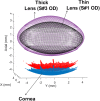Estimation of intraocular lens position from full crystalline lens geometry: towards a new generation of intraocular lens power calculation formulas
- PMID: 29959385
- PMCID: PMC6026180
- DOI: 10.1038/s41598-018-28272-6
Estimation of intraocular lens position from full crystalline lens geometry: towards a new generation of intraocular lens power calculation formulas
Abstract
In a cataract surgery, the opacified crystalline lens is replaced by an artificial intraocular lens (IOL). To optimize the visual quality after surgery, the intraocular lens to be implanted must be selected preoperatively for every individual patient. Different generations of formulas have been proposed for selecting the intraocular lens dioptric power as a function of its estimated postoperative position. However, very few formulas include crystalline lens information, in most cases only one-dimensional. The present study proposes a new formula to preoperatively estimate the postoperative IOL position (ELP) based on information of the 3-dimensional full shape of the crystalline lens, obtained from quantitative eye anterior segment optical coherence tomography imaging. Real patients were measured before and after cataract surgery (IOL implantation). The IOL position and the postoperative refraction estimation errors were calculated by subtracting the preoperative estimations from the actual values measured after surgery. The proposed ELP formula produced lower estimation errors for both parameters -ELP and refraction- than the predictions obtained with standard state-of-the-art methods, and opens new avenues to the development of new generation IOL power calculation formulas that improve refractive and visual outcomes.
Conflict of interest statement
The authors declare no competing interests.
Figures





Similar articles
-
Accuracy of intraocular lens power calculation formulas using a swept-source optical biometer.PLoS One. 2020 Jan 14;15(1):e0227638. doi: 10.1371/journal.pone.0227638. eCollection 2020. PLoS One. 2020. PMID: 31935241 Free PMC article.
-
The effect of ocular biometric factors on the accuracy of various IOL power calculation formulas.BMC Ophthalmol. 2017 May 2;17(1):62. doi: 10.1186/s12886-017-0454-y. BMC Ophthalmol. 2017. PMID: 28464806 Free PMC article.
-
Accuracy of predicted refraction with multifocal intraocular lenses using two biometry measurement devices and multiple intraocular lens power calculation formulas.Clin Exp Ophthalmol. 2015 May-Jun;43(4):328-34. doi: 10.1111/ceo.12478. Epub 2015 Jan 14. Clin Exp Ophthalmol. 2015. PMID: 25491591
-
Pediatric intraocular lens power calculations.Curr Opin Ophthalmol. 2012 Sep;23(5):388-93. doi: 10.1097/ICU.0b013e32835622f8. Curr Opin Ophthalmol. 2012. PMID: 22890001 Review.
-
Intraocular Lens Power Calculations in Eyes with Previous Corneal Refractive Surgery: Review and Expert Opinion.Ophthalmology. 2021 Nov;128(11):e121-e131. doi: 10.1016/j.ophtha.2020.06.054. Epub 2020 Jun 29. Ophthalmology. 2021. PMID: 32615201 Review.
Cited by
-
Estimation of the full shape of the crystalline lens from OCT: validation using stretched donor lenses.Biomed Opt Express. 2023 Jul 25;14(8):4261-4276. doi: 10.1364/BOE.493795. eCollection 2023 Aug 1. Biomed Opt Express. 2023. PMID: 37799671 Free PMC article.
-
Estimation of Crystalline Lens Material Properties From Patient Accommodation Data and Finite Element Models.Invest Ophthalmol Vis Sci. 2023 Aug 1;64(11):31. doi: 10.1167/iovs.64.11.31. Invest Ophthalmol Vis Sci. 2023. PMID: 37639248 Free PMC article.
-
Relationship between Crystalline Lens Thickness and Shape and the Identification of Anterior Ocular Segment Parameters for Predicting the Intraocular Lens Position after Cataract Surgery.Biomed Res Int. 2019 Jul 8;2019:3458548. doi: 10.1155/2019/3458548. eCollection 2019. Biomed Res Int. 2019. PMID: 31360711 Free PMC article. Clinical Trial.
-
High speed, long range, deep penetration swept source OCT for structural and angiographic imaging of the anterior eye.Sci Rep. 2022 Jan 19;12(1):992. doi: 10.1038/s41598-022-04784-0. Sci Rep. 2022. PMID: 35046423 Free PMC article.
-
AI-powered effective lens position prediction improves the accuracy of existing lens formulas.Br J Ophthalmol. 2022 Sep;106(9):1222-1226. doi: 10.1136/bjophthalmol-2020-318321. Epub 2021 Apr 9. Br J Ophthalmol. 2022. PMID: 33836989 Free PMC article.
References
-
- Binkhorst RD. The optical design of intraocular lens implants. Ophthalmic Surg. 1975;6:17–31. - PubMed
Publication types
MeSH terms
Grants and funding
- 294099/ERC_/European Research Council/International
- FIS2014-56643-R/Ministry of Economy and Competitiveness | Consejo Superior de Investigaciones Científicas (Spanish National Research Council)/International
- FIS2011-25637/Ministry of Economy and Competitiveness | Consejo Superior de Investigaciones Científicas (Spanish National Research Council)/International
- ERC-2011-AdG- 294099/EC | Seventh Framework Programme (European Union Seventh Framework Programme)/International
LinkOut - more resources
Full Text Sources
Other Literature Sources
Medical

